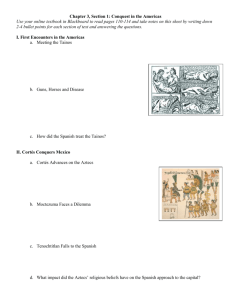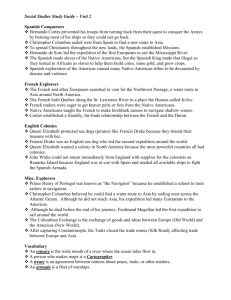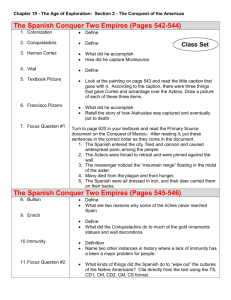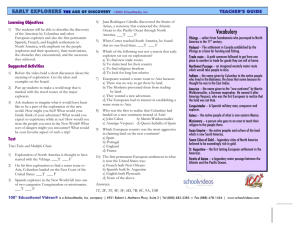Explain the roles of explorers and conquistadors
advertisement
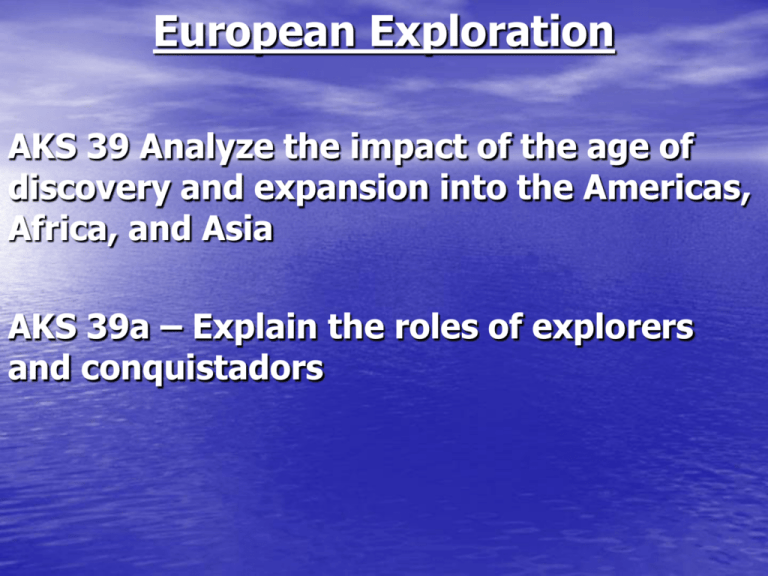
European Exploration AKS 39 Analyze the impact of the age of discovery and expansion into the Americas, Africa, and Asia AKS 39a – Explain the roles of explorers and conquistadors 1. What were Bartolomeu Dias’ three goals for exploration? (p. 530) a. To serve God and His Majesty b. To give light to those who were in the darkness. c. Grow rich as all men desire to do. (Gold) 2. What was the main significance of Vasco DaGama’s exploration of the East Coast of Africa and beyond? (p. 532) Sailors brought back numerous spices, silks, and gems worth 60 times the cost of the voyage and it gave Portugal a direct sea route to Asia. 3. China’s explorations in the early 1400’s were led by Zheng He. What was unique about his seven major voyages? (p. 537) Size, distance traveled, fleet size, and ship measurements. Voyages of Zheng He 4. What was Columbus attempting to accomplish on his voyage in 1492? (p. 553) He was searching for an alternate westward trade route to Asia and it’s riches. Columbus’ Voyages 5. What was the significance of the voyage of Ferdinand Magellan? How many were able to complete the voyage? It was the first voyage to circumnavigate the globe. Only 18 men and 1 ship survived. Magellan was killed in the Phillipines. Voyage of Magellan What were the accomplishments of the following explorers? (p. 561) Verazzano – Sailed in search of sea route to the Pacific; discovered what is New York harbor today. Killed and eaten by Carib Indians in the Lesser Antilles. Cartier – discovered and named the St. Lawrence River; founded the site that later became known as Montreal. De Champlain – Sailed up the St. Lawrence with 32 colonists; founded Quebec, which became the base of the colonial empire of France in North America. Marquette and Joliet – explored the Great Lakes and the upper Mississippi. Joliet Marquette AKS 39b – Define the Columbian Exchange and its global economic and cultural impact 10.What was the Columbian Exchange and how did it work? (p. 571) The global transfer of foods, plants, and animals during the colonization of the Americas; ships from the Americas brought back a wide array of items the Europeans had never before seen and Europeans introduced various livestock animals and foods and grains from Africa. 11.What were the most important products that traveled from the Americas to the rest of the world? (p. 571) Corn and potatoes 12. What were the primary products and animals that came from Europe and Asia? (p. 571) Livestock, (horses, cattle, sheep, and pigs), foods from Africa, (bananas, black-eyed peas, and yams) and grains, (wheat, rice, barley, oats) 13.What was the major negative that came out of the Columbian Exchange? (p. 571) Diseases such as smallpox, measles, etc.., led to the deaths of millions of Native Americans. AKS 39c – Explain the role of the improved technology in European exploration including the astrolabe. 14.How was the new ship design, the caravel, superior to older designed vessels? (p. 530) It was more sturdy than earlier vessels. Triangular sails allowed it to sail effectively against the wind. • 15. What was the significance of the invention of the astrolabe to navigation? (p. 530) • Using the rings to site the stars, a captain could calculate latitude, or how far north or south of the equator the ship was. Vocabulary Prince Henry the Navigator (1394-1460)Prince Henry established a school for the study of the arts of navigation, mapmaking, and shipbuilding. This would allow sailors to better guide their ships and to come up with new ship designs. His goal was to find a route to the rich spice trade of the Indies and to explore the west coast of Africa. Although he never sailed on the expeditions, the voyages that he paid for in the mid-1400s helped launch Portugal into the front of the race to find a sea route to the Indies. Prince Henry monument Lisbon, Portugal Treaty of Tordesillas – The Treaty of Tordesillas was agreed upon by the Spanish and the Portuguese to clear up confusion on newly claimed land in the New World. In order make trade more efficient, Portugal attempted to find a direct water route to the India and China. By using a direct water route, Arab merchants, who owned land trade routes, were not able to make a profit off of the European trade merchants. The Portuguese also wanted to protect their monopoly on the trade route to Africa and felt threatened. On May 4, 1493 Pope Alexander VI took action to clear up any confusion that may have arisen over territorial claims. He issued a decree which established an imaginary line running north and south through the mid-Atlantic, 100 leagues (480 km) from the Cape Verde islands. Spain would have possession of any unclaimed territories to the west of the line and Portugal would have possession of any unclaimed territory to the east of the line. After further exploration, the Portuguese grew dissatisfied with the agreement when they realized how much more land Spain had been given. In June of 1494 the line was re-negotiated and the agreement was officially ratified during a meeting in the Spanish town of Tordesillas. The Treaty of Tordesillas re-established the line 370 leagues (1,770 km) west of the Cape Verde Islands. Dutch East India Company – The Dutch East India Company was a joint stock company who monopolized the spice trade of the 17th century. They established trading ports all over Asia. The Dutch East India Company sought a way to bypass the Portuguese stronghold on the spice trade with the Far East. With the formation of the Dutch East India Company in 1602, the Dutch revolutionized global trade, establishing factories, ports and settlements all over the Pacific. The Dutch East India Company peaked in 1669, when they employed over 10,000 soldiers, 40 warships and 150 merchant ships. Internal struggles, coupled with unrest in their settlements led to a decline for the joint stock company. Hernando Cortes – (1485-1547) Hernán Cortés was a Spanish explorer who is famous mainly for his march across Mexico and his conquering of the Aztec Empire in Mexico. Cortés arrived in Mexico in March 1519 with a group of about 600 men and a few horses. In November of 1519, Cortés and his men reached the Aztec capital and met Montezuma. The Aztecs may have thought that Cortés was a god-king. He conquered Tenochtitlan in the summer of 1521. Conquistadors – The Spanish word Conquistador means conqueror. The Conquistadors were Spanish Soldiers and Explorers - 'el conquistador‘. The Spanish explorers / soldiers saw their mission to conquer new lands as a natural extension of the Medieval crusades. Roman Catholic Priests and Friars always accompanied the Spanish explorers who were expected to convert heathen natives to Christianity. Motives of the Spanish Conquistadors Wealth - gold, silver and spices Power Prestige Increasing opportunities for Spanish trade Spreading the Catholic Religion to heathen natives Building a Spanish Empire Francisco Pizarro – (1475-1541) Francisco Pizarro was a Spanish conquistador who traveled through much of the Pacific coast of America along Peru. He "discovered" the Incan empire and conquered it brutally and quickly, stealing immense hoards of gold, silver, and other treasures. Jamestown – 1607 First permanent English colony in N. America In 1607, 13 years before the Pilgrims landed in Massachusetts, a group of 104 English men and boys began a settlement on the banks of Virginia's James River. They were sponsored by the Virginia Company of London, whose stockholders hoped to make a profit from the resources of the New World. The community suffered terrible hardships in its early years, but managed to endure, earning the distinction of being America's first permanent English colony. They were instructed by the London Company of Virginia to settle Virginia, find gold, and seek a water route to the Orient. • Pilgrims – 1620 • The Pilgrim saga began with a group of religious dissidents who believed it was necessary to separate from the Church of England. Persecuted in England, these "Separatists" moved to Holland in 1607/1608. The group, joined by other colonists recruited by the venture's financial backers, began the move to America in 1620. • There were 130 passengers and crew. • Landed at Cape Cod. Originally going to Virginia but had to stop due to lack of food and weather.
